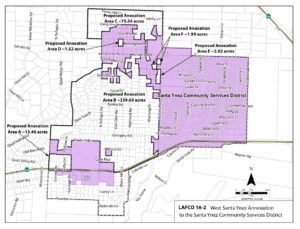
Public can learn more at board meeting June 15
By Raiza Giorgi
The pending westward expansion of the Santa Ynez Community Services District (SYCSD) has raised concerns from many residents in western Santa Ynez after they received a letter titled “Notice of Protest Hearing” without much information regarding what was happening.
The letter from the Santa Barbara Local Agency Formation Commission (LAFCO) announced the opportunity to protest the annexation of 383 homes and 434.82 acres into the sewer district at 11 a.m. June 30 at the SYCSD office, 1070 Faraday St. in Santa Ynez.
A subsequent letter from the SYCSD dated June 9 provided more information and announced a board of directors meeting at 5:30 p.m. Wednesday, June 15, also at the services district’s office.
The district provides wastewater collection through a system that has about 700 customers. The effluent collected is sent to the city of Solvang’s wastewater treatment plant.
Homes and businesses in unincorporated areas outside the SYCSD boundaries rely on septic tanks.
“I haven’t gotten enough information, but from how little notice and information we have received I am at the moment not in favor of this,” said Buzz Clancy, a valley resident whose property is in the annexation area.
Clancy said the LAFCO protest letter dated May 27 looked like junk mail. He happened to hear about the issue from a neighbor and rechecked his mail to find it. The letter included a protest form, but Clancy said some of his neighbors said they had already thrown theirs away.
“I moved to the Santa Ynez Valley so I didn’t have to be told what to do. I don’t like when the government comes in and says what’s best for me,” Clancy said.
The letter from General Manager Jeff Hodge says SYCSD is being “proactive” with the annexation process, which was prompted by new regulations from the state’s Regional Water Quality Control Board regulating septic systems.
If the annexation is approved, the district may receive grants and other assistance to offset the costs of constructing sewer lines where they don’t already exist.
Anyone added to the services district will not be required to connect to SYCSD’s sewer system, he added, but will have a better opportunity to connect if needed.
The 383 homes to be annexed would “be within the District’s boundaries and the SYCSD may provide sewer if you choose or if your septic system fails. You have the option to hook up to the District’s sewer system if there is sewer available in your area,” according to the letter.
If a homeowner with a failing septic tank had to annex to the district alone, it would typically cost about $5,000, according to Hodge, compared to about $200 for a home within the district.
The SYCSD’s website, www.sycsd.com, has been disabled. Its phone number is 688-3008. Hodge’s email is jhodge@sycsd.com. LAFCO can be reached at 568-3391 or lafco@sblafco.org.
In a separate but related issue, Los Olivos residents filed an appeal after learning that the SYCSD had applied to LAFCO to annex their area in March. They went before the LAFCO board on June 2 and got a decision to delay the application for six months until more studies are done, according to Mark Herthel of the Los Olivos Wastewater Steering Committee.
“We are excited the county is moving forward with the focus feasibility study … the committee is sponsoring the financial feasibility study, and we hope to have results by the end of July, which we will present and hopefully make a decision at our September forum,” Herthel said.
The unincorporated town of about 1,000 people has been plagued for decades by failing septic systems. Santa Barbara County declared Los Olivos a “special problems area” in 1974 because of its septic problems.
Los Olivos’ issue is a high water table, which prevents separation between groundwater and the effluent in septic leach fields, according to a report done by MNS Engineers in 2010, so that wastewater can come into direct contact with the groundwater.
A septic system that fails, especially if it is not up to current standards, can cost thousands of dollars to upgrade, according to David Brummond, supervisor with the county’s Division of Environmental Health Services.
The county has recommended forming a special district that would assess Los Olivos customers to pay for a system that pumps treated waste from individual septic tanks to a communal tank for further treatment and then disposal on a common leach field.
To read the revised draft of the Los Olivos Wastewater Management Plan online, go to http://www.losolivoswastewater.com/committee/





